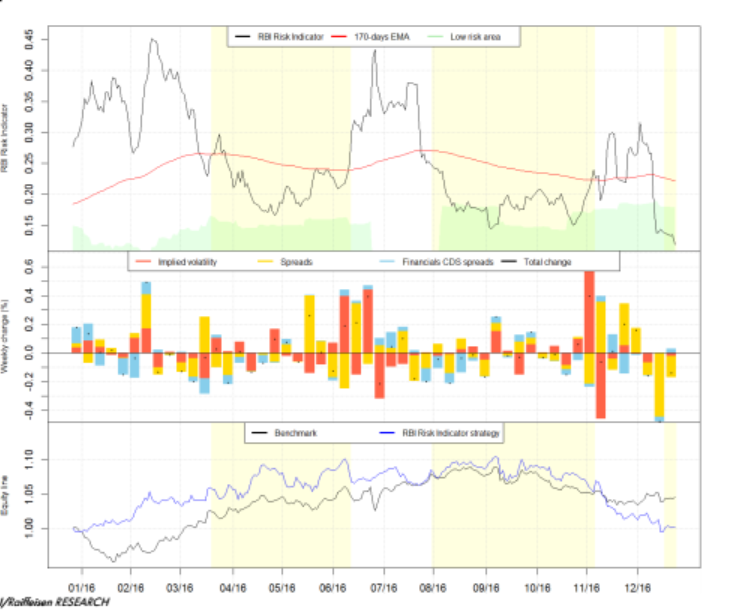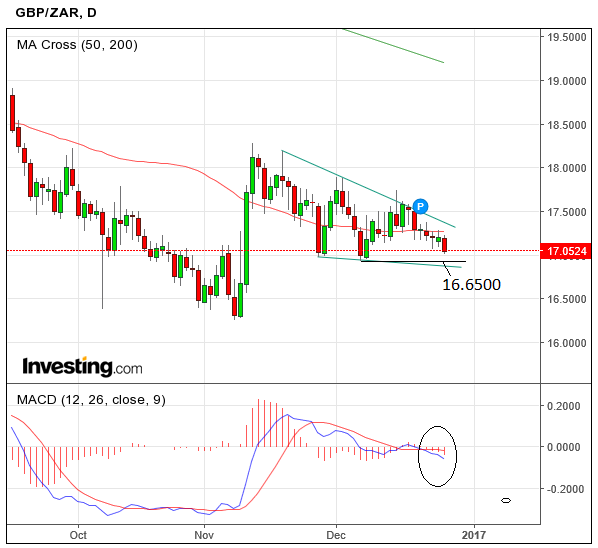The Rand More Likely to Rise This Week As Sentiment Barometer Signals Greater Risk Appetite
One of the most important drivers for the South African Rand is investor appetite for what are regarded as risky investments.
When investors are hungry for risky assets the Rand fairs well; when not, such as when there is a world crisis, the Rand weakens.
Recently the Rand has been slowly but steadily recovering versus the Pound, supported by a rise in general risk appetite as a result of an improving outlook for global growth.
According to Raiffiesen Bank in Vienna, risk appetite is set to improve even further suggesting, even more upside for the Rand.
Raiffiesen have developed a clever risk appetite indicator (see below) which provides a quantitative gauge for determining investor sentiment towards risk.
“The RBI Risk Indicator is a quantitative indicator that should serve primarily as a short-term decision support instrument for high-risk investments,” say Raiffiesen.
“The trading strategy assigns a “buy” rating to risky assets (yellow area) if the risk indicator is sinking below the 170-day moving average (red line) (i.e.in the case of a falling risk aversion),” continues the bank.
Currently, the RBI has just moved below the 170-day MA, indicating that risk sentiment is improving.
Not surprisingly, perhaps, stocks immediately saw gains today when US markets opened for trading.
For the Rand the increase in risk-taking is positive too.
The chart of the RBI Index below shows how the index moves in a rough semi-predictable sine wave, suggesting risk sentiment follows cycles.
This infers that risk appetite is likely to remain elevated for a prolonged period of time, and that the outlook for the Rand is, therefore, probably likely to be positive for at least three or four days whilst the current cycle bottoms.
The expectation of Rand gains on the back of higher risk appetite dovetails neatly with our marginally bearish technical view of GBP/ZAR.
The pair shot up in November but after peaking at 18.3500 in mid-November has spent the time since then slowly descending as the Rand has outperformed the Pound on average.
The currency pair is at risk of further declines but only if it breaks below the 16.9400 lows.
Such a move would lead to a probable capitulation to a target at 16.6500.
Note the MACD indicator has also moved below both the signal line and the zero-line providing a doubly-bearish signal.
Data for the Rand This Week
The South African Trade Balance is out at 12.00 (GMT) on Thursday, December 29, and is expected to show a -0.75bn trade deficit in November.
Money Supply (M3), out at 6.00 on Friday 30 is forecast to slow slightly to 6.5% in November year-on-year.
Private Sector Credit is forecast to rise 5.87% in November when it is released on December 30, also at 6.00.
The Pound is at Risk of Brexit Talk
If there is any further talk of Brexit in the week ahead then that could move the Pound, since data is very thin, with only Mortgage Applications in November in the pipeline, which is forecast to show a rise of 41.6k in November, from 40.3k in October.
Markets are expecting a relatively “Hard” Brexit with an interim period in which the UK will have a special trade agreement with the EU, possibly as a result of purchasing access to the common market or in a quasi Turkish-style membership relationship.
The exact form in which these will take, however, remains unknown.
Save
Save


